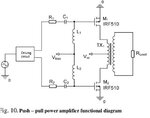sys_eng
Full Member level 4
In the picture, blue color waveform is the output of the tranducer. when at the resonant frequency without the loading, the blue waveform is bigger amplitude than the yellow waveform,
when pressing the hand on the transducer it represents the loading (heavy loading) that change the output , the blue waveform drops to less than the yellow waveform.
How can I design the tranducer such that when heavy loading present, the blue waveform WON"T shift in amplitude and frequency?

when pressing the hand on the transducer it represents the loading (heavy loading) that change the output , the blue waveform drops to less than the yellow waveform.
How can I design the tranducer such that when heavy loading present, the blue waveform WON"T shift in amplitude and frequency?


